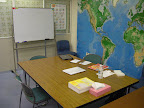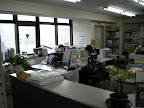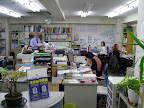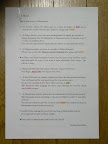Another long post ahead. Maybe I’m making up for lost time. Maybe I’m just long-winded. =)
ALS new teacher training runs five days. As we were hired at about the same time, I was joined in training by Jonathan Nusbaum, an American teacher already in Japan hired away from Margaret’s English School. Day one (Tuesday, April 15th) was all paperwork and introduction to the company, its history, and its major players, as described and facilitated by HR Director Marie Verlingo, who walked Jonathan and me through all the paperwork and helped us wade through the sea of new names. That took place in the ALS head office in Chiba. Here’s a picture of the room in which I spent the day.

As you can see, I used my laptop to take notes- nine pages over four days, in fact.
Day two was in Yotsukaido, the Tokyo suburb where the company guest house is located, this time facilitated by Jack Stearn. Jack Stearn, for those of you who haven’t met him, is an incredible children’s educator. He doesn’t quite have enough notoriety to have a Wikipedia page yet, but he certainly deserves one. Originally from the northwestern US, he’s been teaching English as a Foreign Language in Japan for twenty years, and it shows. His lesson plans are beautifully crafted pieces of art, and his command of children’s psychology should earn him an honorary doctorate. He’s the teacher with the most tenure at ALS, and seems to have a finger in a few other pieces of the business as well. As you may have guessed, we talked about teaching theory, specifically as it applies to children. We also covered lesson planning and why it’s important. Here are a couple pictures of the ALS head office, by the way:


Starting from the left, there’s Junya Sasaki, the company’s accountant, and a friend of the company’s owner, Mr. Saito. Hired to clean house, Junya (as he prefers to be called) replaced two (three?) other full-time accountants, and works long hours to prove it. Unfortunately, I’m not sure of the woman’s name across from him, but I think it’s Sachiko, who handles internal logistics and travel. The eyes just peeking over the copier belong to Jon Clark. Jon is another excellent educator, though he doesn’t have quite the same tenure as Jack. He’s Canadian, though I promised not to hold it against him, as are Marie and Dominique. Jon’s forte is slightly older children, though I’d be hard pressed to find any student he couldn’t teach to write a treatise on War & Peace if he had a few weeks to devote.
Standing to Jon’s left is the aforementioned Mr. Stearn. Though I’m not entirely sure, I think Yoko Uekusa is the one closely studying the papers on the desk in front of her. In the back wearing the white shirt and short hair is Marie Verlingo. Marie is the one I spoke with on the phone for my second interview, the one that gave me the official “hire†decision. To the far right side of the frame, head in mid-spin, is Dominique Parker. Dominique is the one I spoke with on the phone for my initial interview. Marie and Dominique are both Canadian, which means almost half of the people that work in the American Language School head office are Canadian. Canadia is part of America too, so that’s okay.
Day three was also in Yotsukaido. The morning session was with Junko Yoshimoto, and focused on the *really* young children, aged three through five. ALS has an interesting program for kids that young. They call it the “Rhythmic Program,†and it basically consists of playing with the kids in English and singing songs in English, with maybe some repetition of basic English sounds. This happens in small groups with the parents and a Japanese teacher present, in a team-teach setup. I don’t know how much those “classes†cost, but they can’t be cheap. After lunch, Junko stepped out and Jon stepped in.
I’m going to stop my dry narrative here for a minute to let you in my head a little bit. Like I mentioned before, Jack is a seriously good teacher- intimidatingly so, in fact. Monday and Tuesday nights I was sent home with a video of an example lesson to watch (perfectly planned and executed my Misters Clark and Stearn). Add to that the fact that I’m a little afraid I’m going to permanently mess up some random Japanese kid (think “No more wire hangers!†from Mommie Dearest, but in my nightmares it’s me swinging the classroom pointer screaming “That’s an R, not an L! Are you retarded?!â€), and you get a palpable amount of stress. What if little Mizuki goes home and tells his parents how the bottom of the instruction level fell out after I came on board? These are real kids in the classroom, not CPR instruction dummies with faces forever frozen in surprise, no matter how many cardiac “massage†beatings they sustain. No, if the children I’ve seen terrorizing Las Vegas businesses for the last two score years are any testament, you can seriously and permanently mess up a child. I hear they’re surprisingly so, but my problem is that I don’t have enough experience to know exactly how resilient kids are.
Jon Clark took that fear from me and made the job real and doable. He talked me through lesson planning for Junior High kids, and somehow I felt like I could actually do this. I’m not sure if it was his general pragmatism that did it or his simplification of the whole affair of teaching in the first place (“If you’re not having fun, you’re doing it wrongâ€), but at the end of the day my head was back on straight. Walking out of school that day was seriously one of those slow motion end of the movie moments for me, where the main character is walking away from the camera and you can hear the music swell and you know the credits are about to roll (I’m thinking Breakfast Club, but just about any John Hughes movie will work).
That night, we had a new arrival at the guest house. Michael Barker arrived from Thailand and moved in upstairs. He was scheduled to arrive on Monday and start training with me on Tuesday, but because he was flying standby at a peak time of the year (national holiday in Thailand), he was unable to get on a plane until Thursday. While I’m talking about Michael’s arrival, I might as well talk about Jonathan’s situation. He was hired to take over for an existing teacher (Deirdre Porter), as we all were. However, as Deirdre had already rather suddenly returned to Canada due to a surprise diagnosis of leukemia, he was not able to attend the second half of each day’s training because he was actually already teaching. (I hear Deirdre’s doing quite well now, by the way.)
Anyway, I brought my refreshed perspective to day four’s adult lesson planning, and it went quite well. The second half of the day was back in Chiba, and I had to navigate my way there without any help for the first time. Michael and I spent the latter half of the day with Marie back in the original training room talking about a few dry topics, as Marie apologetically pointed out a few times. We went over our transition schedules from training to teaching including transportation from the guest house to our actual teaching assignment, how to be a good employee, and signed our actual ALS contracts.
The last day of training was entirely observation of an established teacher in action. As my franchise owner had requested, I was in the classroom with Jack all day. This turned out to be a blessing and a curse, as Jack’s schedule was almost entirely comprised of lessons for young kids, with one private adult lesson at the end of the day. Not awful, but not wholly representative of my eventual solo teaching situation.
I felt like we should have some sort of celebration on Saturday night to celebrate the end of training, but Jonathan was already moving into his new apartment in the neighborhood (his assignment was based in Yotsukaido) and Michael was doing his own thing, so I was left to pack on my own and wonder if I was going to make it from Yotsukaido to Matsuyama without adult supervision.

I read and re-read this set of directions, hoping nothing went wrong along the way while I caught two trains, a monorail, a plane, and a bus to get to Matsuyama Station. Wish me luck!

